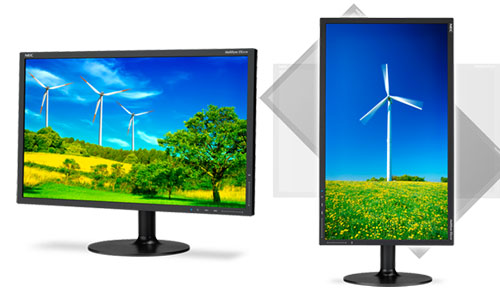
NEC’s new MultiSync EX231W monitor is squarely aimed at corporate users, particularly those in the financial sector. It is fully height adjustable and can be rotated from landscape to portrait mode, making it ideal as a secondary display, particularly for those who wishing to follow real-time market indicators or similar services.
It’s also extremely well suited to Web browsing, reading or editing documents or keeping tabs on Twitter. However, like many “twisted nematic” panels, the viewing angle is extremely specific — in landscape mode tilting it a few degrees backwards results in a far darker image, while tilting it too far forward results in colour shift.
At 23 inches, with an aspect ratio of 16:9, it almost resembles two 17-inch panels rolled into one. It has a resolution of 1920×1080, offers 250cd/m2 of luminance, a 1000:1 contrast ratio (which isn’t astounding but is certainly sufficient for its target market), 8-bit colour depth and a 5ms response time – all of which means it’s suited to casual gamers and movie watchers as well as business sorts, but isn’t ideal for photo or video editors or those who demand colour accuracy.
The LED-backlit panel is extremely slim and lightweight due to the use of an external power supply. The bezel is pleasingly narrow at just 14,6mm. Connection options include DisplayPort, DVI-I (with an included VGA to DVI-I adaptor) and an upstream USB port on the rear and a downstream USB port under a cover on top, clearly intended for connecting a webcam. There’s also a Kensington lock slot for the security minded.
The on-screen display is controlled by touch sensitive buttons on the bottom-right of the bezel. Though the additional on-screen information that aligns with each button to explain their use in each sub menu is a great feature, the on-screen display only works in landscape mode, and the touch interface is so sensitive that merely hovering a finger near a button is enough to make it respond – making overshooting menus a frequent occurrence.
NEC has packed this model with all manner of eco-friendly settings. For example, there’s a menu option that displays estimated carbon savings in various currencies (not in rand). There’s even a “human sensor”, which can be set to dim the screen when it detects there’s no one in front of it.
Unfortunately, even on the lowest brightness setting the sensor is far too sensitive, particularly when the monitor is used as a secondary display and isn’t directly in front of the user, which means it simply goes to sleep repeatedly. It’s a novel feature, but it could certainly be further refined.
The panel comes with a three-year collect-repair-return warranty — comforting considering monitors tend to outlive the computers to which they’re attached. At a recommended retail price of R4 300 (excluding VAT) it’s decidedly more expensive than the bulk of its competitors, and considering the colour shift and lack of differentiating features like built-in sound, headphone or speaker jacks, or otherwise common interfaces such HDMI and VGA, this seems steep. The NEC is nifty, but it’s certainly not for the thrifty. — Craig Wilson, TechCentral
- Subscribe to our free daily newsletter
- Follow us on Twitter or on Facebook




